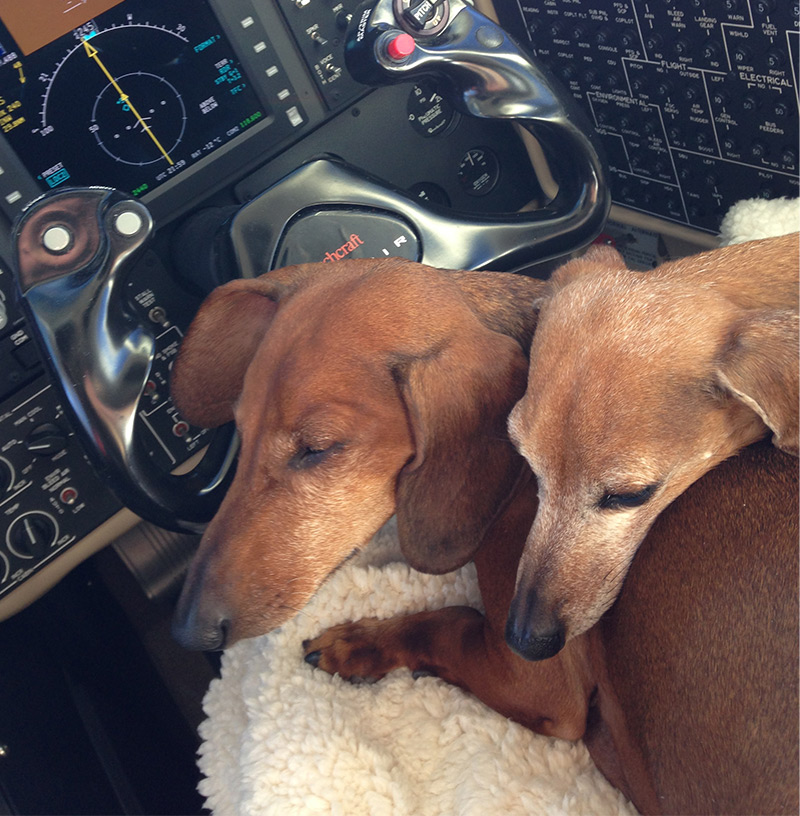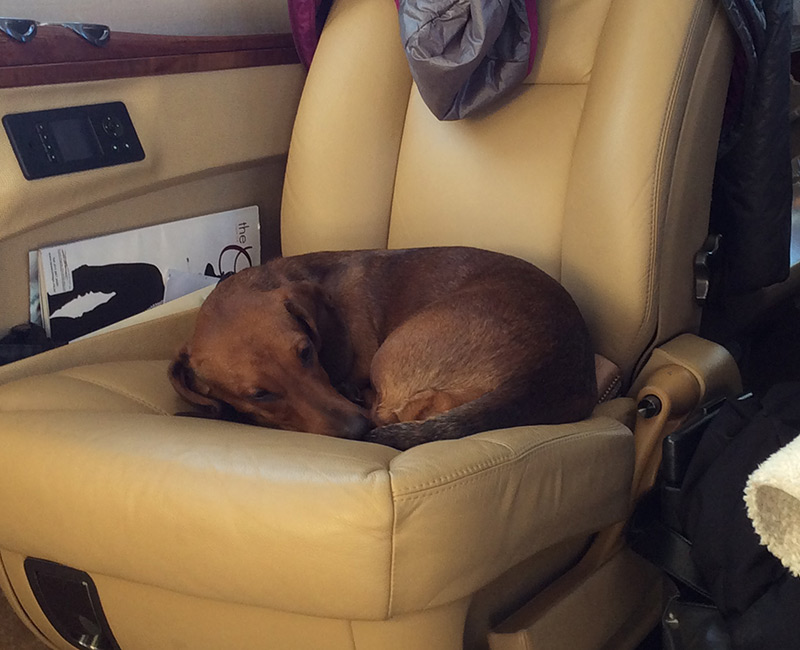A list of the 'paws-abilities'
Sophie, Brandy and Remy are lap dogs. When flying commercially, they are fortunate their weights allow them in the airliners’ main cabins rather than the cargo hold.
Despite this benefit, regulations won’t allow the dogs out of their carriers, which often have to be placed under the seat in front of their owners. As a result, whining soon ensues.
Whining and other signs of stress disappeared when the dogs’ owner purchased a Beechcraft® Baron® G58.
“We don’t have to serve them warm nuts, but they are more relaxed and seem happier,” said their owner, who flies with the dogs when commuting from his family’s home on the east coast to a home in the western United States.
It’s not the first-class amenities the three dogs are after. Routine and comfort—in this case, the lap of one of their owners—make flying privately less stressful than flying commercially.
Bringing pets on board a private aircraft can be less stressful for the pets and their owners and requires a small bit of planning.
Before takeoff
Know the legal requirements
The United States Department of Agriculture regulates air transportation of pets within the U.S. and has just a few requirements: the pet must be at least eight weeks old, be fully weaned and be in good health. The USDA allows individual airlines to impose further restrictions for flying with pets.

Sophie, a miniature dachshund, at the controls of the Beechcraft Baron G58 her owners previously flew.
Each pet that crosses state borders, with the exception of a guide dog, is required by the United States Department of Agriculture to have a rabies immunization and a valid health certificate issued by a licensed veterinarian within 30 days of travel.
For travel outside of the continental U.S., additional paperwork and health care requirements may be necessary. You should contact the foreign office of the country where you are traveling to for more information.
Make sure the animal is healthy
Dr. Christen Skaer, doctor of veterinary medicine, focuses on companion animal medicine, surgery and ophthalmology at her Skaer Veterinary Clinic in Wichita, Kansas, and has a special interest in ophthalmology and animal behavior.
She recommends making an appointment with a veterinarian within 10 days of departure for a general check-up and to obtain a health certificate stating all vaccinations are up to date. She suggests you also use this opportunity to ask your veterinarian for recommendations based on the pet’s age, weight and health condition—for example, the use of medications or the amount of food and water to provide.
Carefully consider medication
The American Veterinary Medical Association discourages giving pets traveling by air tranquilizers because they can increase the risk of heart and respiratory problems. Sedating a pet can also interfere with the animal’s natural ability to react to the environment.
"In most situations, you don’t need to medicate a pet for flight, but it really needs to be considered on a case-by-case basis,” Dr. Skaer said. “It depends on age, weight and many other conditions. That’s another good reason to visit with your vet before traveling.”
See the En Route section below for alternatives to medication for dealing with anxiety.

An easy rule when it comes to pet safety during flight:
If it’s something you provide for yourself or human passengers, you should provide it for your pet.
Limit food and water intake
You should also provide water, but not excessive consumption. This should reduce your animal’s need to use the bathroom during the flight. Feeding pets smaller meals will also reduce the risk of vomiting or an upset stomach.
“For many pets, no meal at all is a good practice, but it depends on the individual pet. A diabetic dog, for example, should have a small meal,” Dr. Skaer said.
Get some exercise
Going for a short walk before a flight can calm you pet’s nerves and allow it to go to the bathroom.
En route
Provide safety
It’s important for humans to buckle up for takeoff, landing and during turbulence, and it’s the same for pets. Having a loose animal in the cabin during these times can be dangerous to the pet, human passengers and the interior of the aircraft.
Some owners outfit their pets with harnesses that connect to the aircraft seat belt, while other owners transport their pets in crates that are secured to the airframe inside the cabin. Whether to leave a pet in a crate for the duration of the flight is a personal decision, but it’s best to have the crate on hand in case it’s needed at any time.
There are also oxygen masks and flotation devices designed specifically for pets. In addition to those devices, you may also want to consider learning CPR and first aid for pets.
Bring stress-eliminators
Bringing along familiar toys or blankets can help ease the stress of flying for a pet. There are also many products on the market that claim to help soothe a pet during anxious conditions like a flight. It’s best to try the products out in advance, if possible.

Brandy and Sophie tried out the right seat for a moment on their owners’ King Air 250. Today when they travel, it’s on a Citation® CJ4®.
One item Dr. Skaer has seen effectively calm both cats and dogs during travel, storms, boarding or visits to the vet is a shirt that applies a gentle, constant pressure to the pet.
“It’s like swaddling a baby,” she said. “I’ve seen a number of cases where a Thunder Shirt has helped to decrease anxiety.”
Another product Skaer has experienced first-hand: synthetic pheromones.
“These mimic natural pheromones that a mom cat or dog might release to relax her baby,” Dr. Skaer said. “They work to calm many scared animals. You can buy them in the form of a collar, a spray or even a wipe that could be used on the inside of a pet carrier before flight.”
From smell to touch to sight to sound—anxiety can come in many forms. Brandy wears noise-reducing earmuffs made for pets.
Provide water and have a plan for in-flight relief
The pet should have access to water for the duration of the flight. On short flights, pets might be able to make the entire trip without going to the bathroom, especially if they’ve received a limited amount of food and water beforehand. However, it’s best to have a plan in place should the need arise. Depending on the animal, owners may choose to bring a litter box, training pads or a number of other products on the market that offer clean, in-flight relief.
Upon landing
Provide food and water
Depending on the length of the trip and how your pet handled the flight, it might be hungry and thirsty upon landing. Allow the animal plenty of water and an appropriate amount of food.

Remy, the newest member of the family, cuddles up on board her owners’ aircraft.
Get more exercise
Going for a walk soon after the flight will help an animal acclimate.
The dachshund sisters, Sophie and Brandy, are the perfect example of how each dog reacts differently to flying. Brandy takes a low dosage of an anti-anxiety drug and wears earmuffs during the flight. Sophie takes no medication and won’t wear anything covering her ears. Both like to be on an owner’s lap or sleeping under a familiar blanket during the flight.
There is no question. Flying privately makes the trips easier on the dogs and the owners.
Videos and stories contained in this site may contain information that while accurate at the time of publication, has since been updated. Please connect with a representative for any questions.